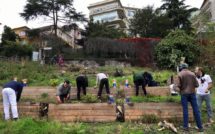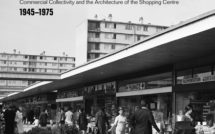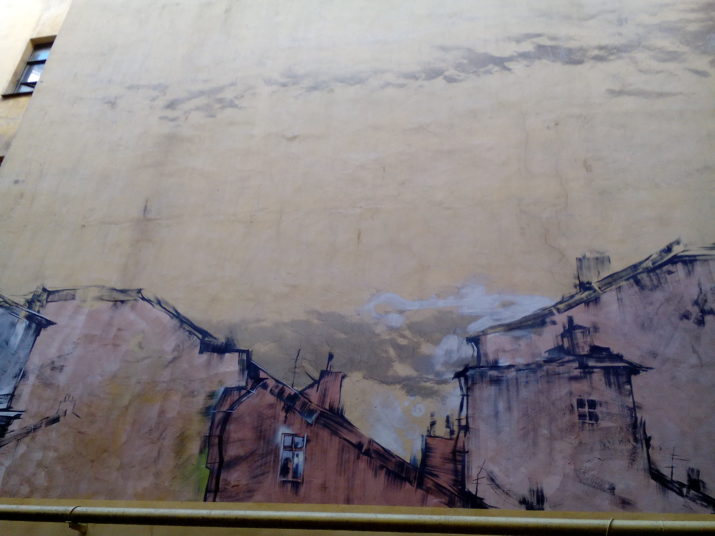
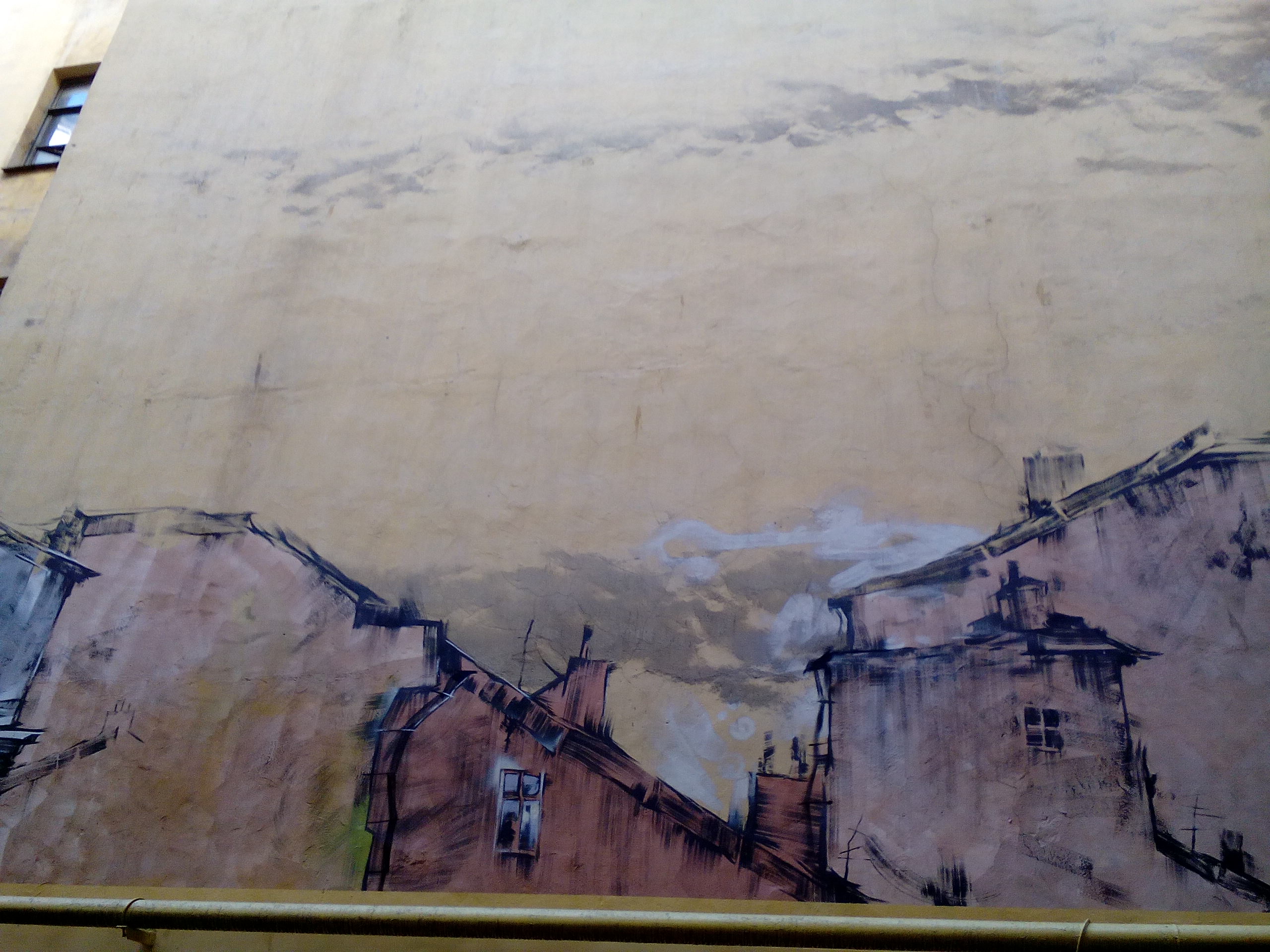 This is part of our special feature, Contemporary Urban Research in the European City.
This is part of our special feature, Contemporary Urban Research in the European City.
This comparative research project on Saint Petersburg and Berlin´s public spaces, Claiming the public space, funded by the Alexander von Humboldt Foundation, was developed on the base of previous activities – such as, an exhibition on Urban Ornaments in Berlin 2015, or a conference on post-socialist cities in Marburg 2015, and a lecture on horizontal urban planning in London 2016.[1] These activities were realized by an international research network (TACT), established in Berlin 2013. Involving academics, artists, urban activists, and students, TACT created a platform for exploring urban imaginaries, public spaces, and the urban interventionism of street art and grassroots activism.
This network involves people from different disciplinary backgrounds, including urban anthropology, sociology, art history, urban history, geography, architecture, and art. It creates an important arena for the exchange of ideas through workshops, projects, events, and publications, and seeks to encourage new cross-disciplinary collaborations. Through an international comparative focus on cities such as Berlin, Istanbul, London, Moscow, Budapest, and St. Petersburg, it aims to generate an innovative dialogue between post-socialist, global, or globalizing cities. Nevertheless, at the first sight, these mentioned cities, namely Saint Petersburg and Berlin, could not have been more different from one another—an industrial, ambitious metropolis in the center of the continental Europe with a difficult history and many revivals on the one hand, and a beautifully constructed and planned imperial city, today full of heritage sites, on the other. However, in the mentioned research project, we linked these two cities, highlighting the issue that connects them and provides simultaneously the basis for the exchange: the struggle for urban public spaces. Although the reasons and challenges behind the conflicts for urban public spaces are partly different, in the context of globalization many of these issues and challenges have the same roots. Challenges such as tourism, rising housing costs, securitization, and so on, have their strong impact on the accessibility of urban public spaces, and so on the publicness of urban public spaces.
The academic research is also sensitized to this issue, since Richard Sennett’s ground-breaking work, The Fall of Public Man (1977)[2] on the disappearance of urban public spaces due increasing privatization in American cities. Sennett argues that, among other factors, increasing privatization and commercialization in U.S cities caused this phenomenon. Delayed by several years, these process phenomena led to the displacement of public spaces in Europe as well. A correspondingly wide discussion on this was then referenced in the European urban research too.[3] (Eckart, 2012). Over the last ten years, in particular, this has been accompanied by a wave of lively debates, both in academia and in public opinion, for example, on gentrification[4] (Holm/Gebhardt, 2011), and on “The Right to the City” movement[5] (based on Lefebvre’s publication from 1969). In turn, this discourse raised the issue of the new participants acting in public space and on their often-colliding interests on the use of urban public spaces. Consequently, this was followed by the observation of the sociologists, Frey and Koch, who stated that the concept of public space over its long history had always been associated with issues and demands regarding access to certain urban areas (Frey/Koch, 2011).[6] The demands for access to urban public spaces led to the strengthening of multiplication of various urban actors, who are claiming access to public spaces. (Carmona 2010).[7] Accordingly, we assumed in the project, that firstly, the growing number of, and difference between the participants attracts a stronger and increasingly more visible struggle for access to public space (Friesinger, 2010).[8] Secondly, the conflict of interest and use among the different participants concerning public space is increasing, which requires new forms of negotiations between these interests.
Movements, such as the Right to the city, made it clear that urban public spaces, the existence of them, and the access to them, was not a basic right anymore.. The history of the concept of public space and the public itself – that placed the connection between the built, physical space and the exercise of political rights in the center of the European political and philosophical tradition – has its roots in the Greek city-state (Polis) (Siebel, 2004)[9]. The connection between public space and the public was fundamental for the European urban history, and since the 18th century it represents – both as a normative medium and as a requirement for legal, rational governance – a core value of the European political culture. For a relatively long time, the understanding of public space was determined by the theory of Jürgen Habermas.His work The Structural Transformation of the Public Sphere (1962) became one of the most influential books after 1945. At the same time, while it had a long-lasting effect on the image and understanding of urban public space, Habermas’ concept of an ideal arena, in which – he argued – consensus was reached through the critical dialogue among the public, has also provoked much criticism. By now, urban public spaces – as it had been already emphasized – became strongly contested resources (Carmona 2010), where the right to these spaces is claimed by multiple agents with conflicting interests.
We witnessed exactly these experiences of disappearing and threatened urban public spaces both in Berlin and in Saint Petersburg. However, we argued, there is an exchange of best practices between various urban actors in the struggle for urban public spaces. This exchange was and is still in the focus of the research on urban interventions between Berlin and Saint Petersburg. In frames of field researches and with methods of the social sciences, we are mapping the tools and the ways of negotiating the access to public spaces.
While in Berlin, this happens often with the tools of architecture or artistic interventions. In Saint Petersburg, for example, the various NGO-s and associations choose more the social actions, such as organizing flash mobs or markets,. One of the groups became active and involved in the discussion about the reconstruction of the historical central area, called Peski. Besides using social media platforms, such as the VK, this NGO, called Mytny Dvor,[10] organizes various actions in the neighborhood – like walking tours with locals to explore the historical sites – and, at the same time, they negotiate constantly with the municipality about this district´s presence and future. All documents of this negotiation are published on their site. This functions as a sort of archive of the bottom up ideas and documents the process of participation as well. The aim of this initiative is to transform the area of Mytny Dvor into a recreational green, pedestrian zone. Instead of new “luxury” residential in every free spot, this NGO-s proclaims the protection and reconstruction of the mostly nineteenth century buildings, also in order to preserve the historical architectural context of the area.

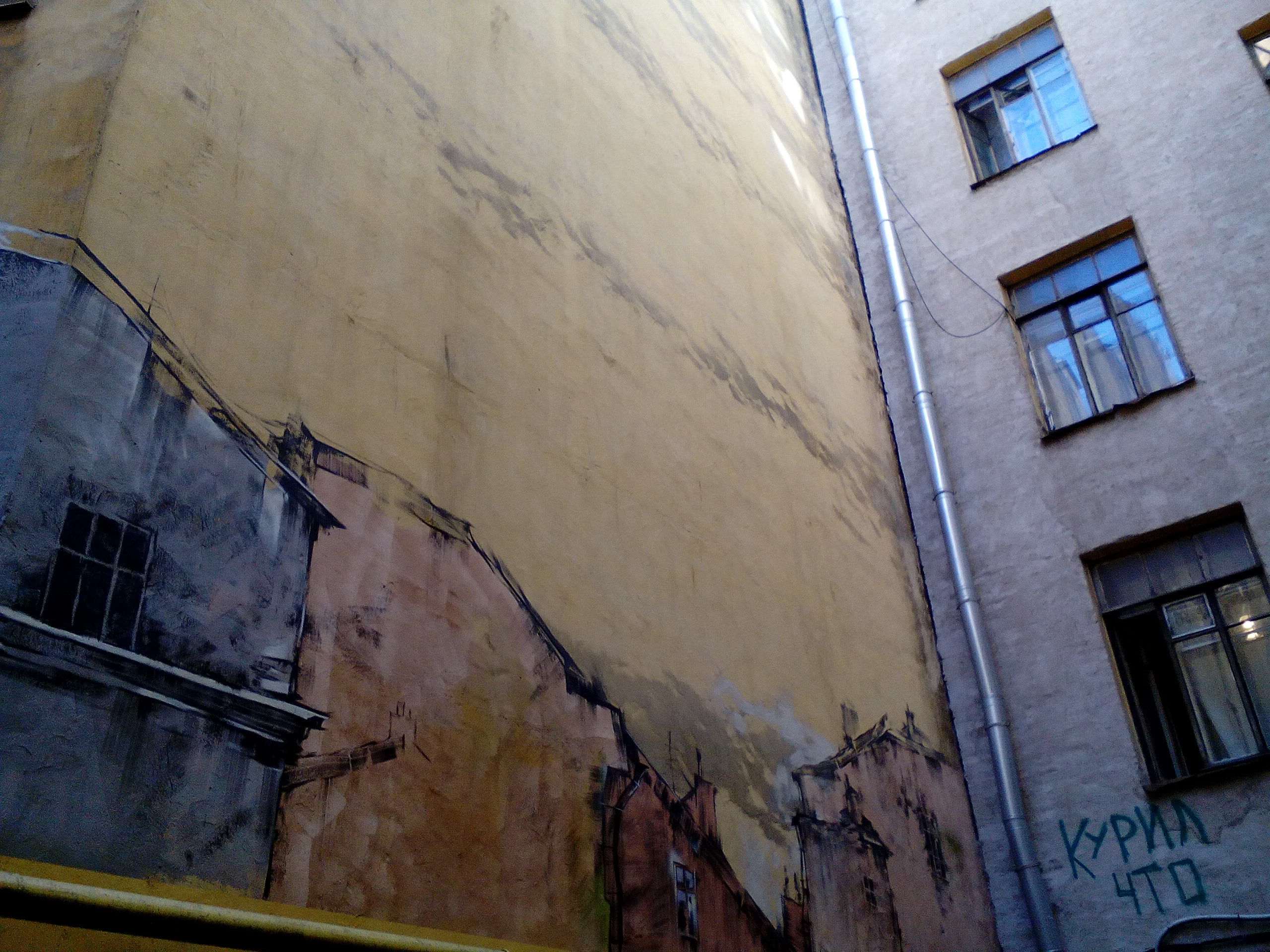
Figure 1 and Figure 2 – Saint Petersburg I-II © Courtesy of Eszter Gantner
While in Saint Petersburg, as mentioned, mostly social interventions linked with social media are the fundament for urban activism. In Berlin, many of the bottom up projects are realized with the tools of planning and architecture. The Tempelhofer Feld is perhaps the most emblematic and well-known project illustrating this kind of activism.[11] Another less known example, is the Holzmarkt initiative. This citizens’ initiative grew in response to the plans for the Media Spree which were designed as part of urban development policy in the 1990s. According to the plans, predominantly office space and head offices but also luxury lofts, hotels and multi-purpose halls were to be built on disused or temporarily used land along the banks of the Spree between the Jannowitz and Elsen bridges, along the former Berlin Wall. Opposition to the dense development of the river bank was duly organized and reached its initial peak in 2008 when 87 percent of the voting population from Friedrichshain-Kreuzberg supported the Spreeufer for all referendum.[12] Following the referendum, and also subsequently legitimized by it, the Holzmarkt initiative took up the idea of the cooperative and acquired the Holzmarkt site with the aid of the Swiss foundation Abendrot in October 2012. The ideas, plans, expert opinions, as well as the capital for the sustainable design of the site were collected in the cooperative for urban creativity. The intensive Internet campaign, the diverse interventions of the cooperative – such as Urban Gardening in Mörchenpark,[13] which is landscaped regularly with neighbors and volunteers – mobilized the expertise of individuals, created a sense of community and conveys the vision of inclusive urban planning.
In this context, we consider urban interventions to be practices in which the most diverse participants make their socio-political positions and genuine private interests clear and visible and exert their influence on the public space. The observations made here, and the developments discussed, are, in part, already known to urban research. However, this new diversity and its associated conflicts of different demands for access to public space pose great challenges for urban policy, city administration and also planning. Urban interventions are being initiated by a diverse group of urban actors whose legitimation is based on an expertise rooted in everyday experience and active participation, as the examples presented here have shown.
These participants demand access to public space: they demand participation in planning and sharing in the space production and they want to have a say in how their city develops.
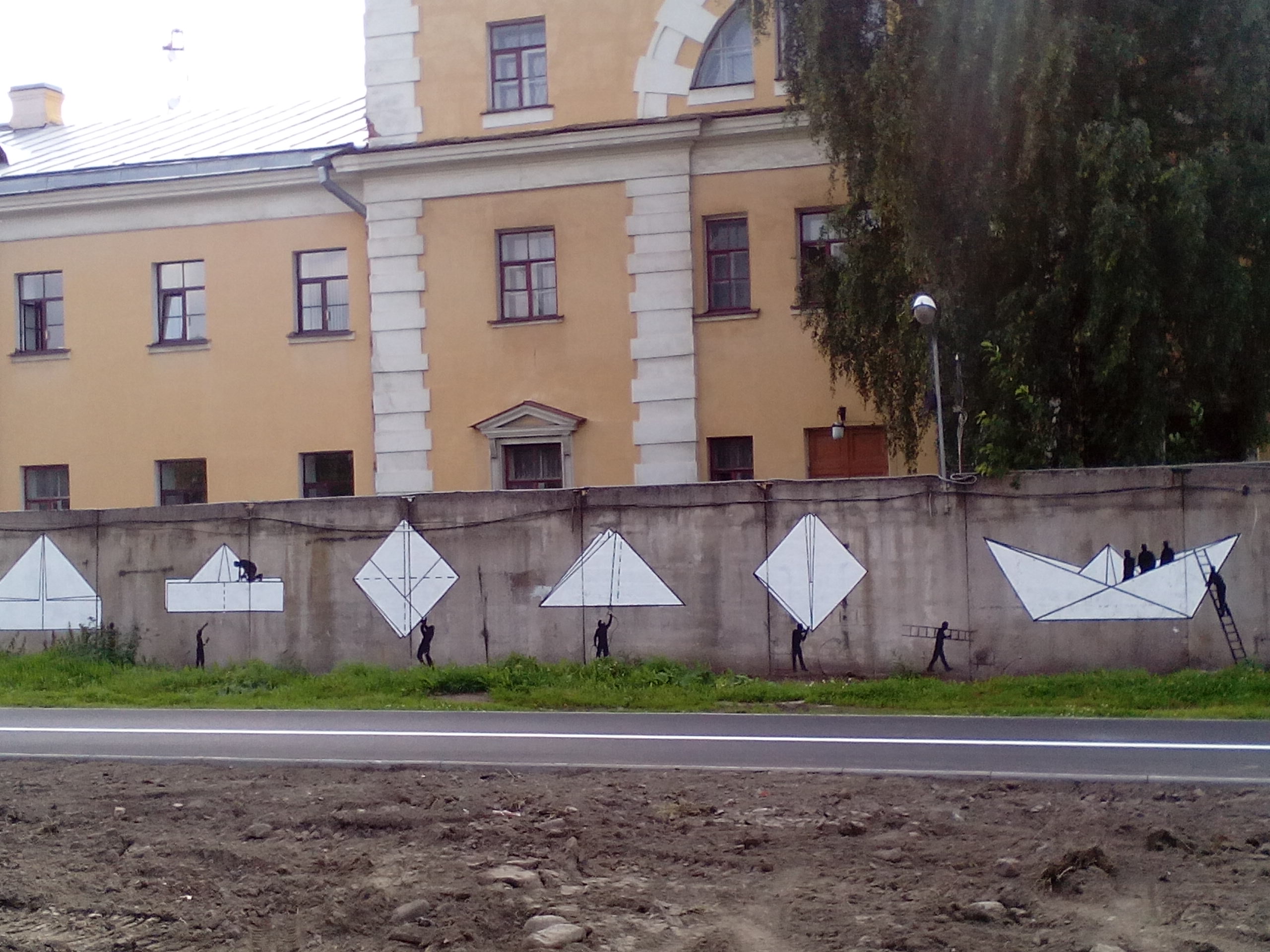
Figure 3 – Saint Petersburg III © Courtesy of Eszter Gantner
Eszter Gantner holds a Ph.D. in History from the Humboldt University of Berlin. She has studied Law, History and Political Sciences in Budapest, Jerusalem, and Berlin. Gantner has been a visiting scholar at the Harriman Institute, Columbia University, in 2015 and 2016. Currently she is academic employee and project coordinator (LOEWE) at the Herder-Institute for Historical Research on East Central Europe, where she completed a book project, Knowledge Transfer and Urbanization in East Central Europe 1873-1914. Simultaneously, she leads with Oleg Pachenkov the TACT-Project “Claiming the public space” funded by the Alexander von Humboldt Foundation and located at the Georg Simmel Center for Metropolitan Research-Humboldt University of Berlin. Her research fields include: history of science and knowledge, urban history (with focus on East Central Europe), intellectual history of Europe, material culture history, digital humanities in East Central Europe, and Jewish history of East Central Europe.
References:
[1] https://tactcity.wordpress.com/tact-meetings, retrived on April 10 2018
[2] Sennett, Richard (1977): The Fall of Public Man. New York.
[3] Eckart, Frank (2012): Handbuch Stadtsoziologie. Wiesbaden.
[4]Gebhardt, Dirk/Andrej Holm (ed.) (2011): Initiativen für ein Recht auf Stadt.
[5] Influenced strongly by Lefebvre, Henry (1969): Le droit à la ville. Paris.
[6] Frey, Oliver/Florian Koch (ed.) (2011): Die Zukunft der europäischen Stadt. Wiesbaden.
[7] Carmona, Matthew/Heath, Tim 2010. Public places, Urban spaces, edited by Matthew Carmona, Tim Heath. Oxford: Architectural Press
[8] Günther Friesinger, u.a. (ed) (2010): Urban Hacking. Cultural Jamming Strategies in the Risky Spaces of Modernity. Bielefeld
[9] Walter Siebel:
[10] https://vk.com/mytndvor, on 10.04.2018
[11]Kaschuba, Wolfgang (2013): Vom Tahrir-Platz in Kairo zum Hermannplatz in Berlin: urbane Räume als »claims« und »commons«? Raumanthropologische Betrachtungen. In: Bertuzzo et al (ed.): Kontrolle öffentlicher Räume. unterstützen, unterdrücken, unterhalten, unterwandern. Berlin u.a, 20-56
[12] http://www.holzmarkt.com/, retrieved on 10.04.2018
[13] http://www.moerchenpark.de, retrieved on 10.04.2018
Published on May 1, 2018.

